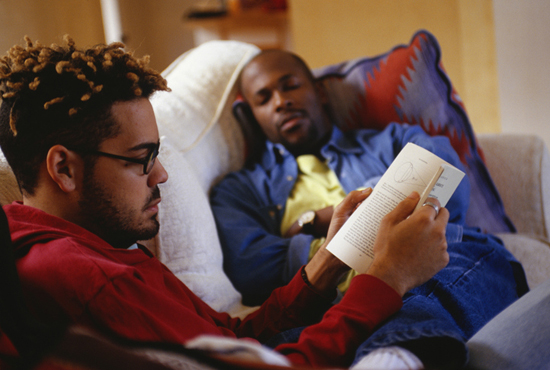Web Exclusive
Advocating for LGBTQ People of Color In the United States, black and brown teenagers between the ages of 13 and 18 years of age who identify as LGBTQ face a unique set of health determinants our heterosexual counterparts do not experience. LGBTQ youth of color are disproportionately more likely to contract an STD and experience mental health issues, homelessness, poverty, harassment, and sexual assault. Reasons are simple: homophobia, transphobia, discrimination, and stigma surrounding HIV in communities of color. To better understand the challenges of this marginalized population, social workers must be willing to adopt new practices and explore their own biases when regarding the intersections of race, sexual identity, gender, and religion. Religious and Postslavery Roots Black religion institutions often refer to several Biblical passages that they interpret as prohibiting same-sex sexual behavior (i.e., Genesis 19:1-29, Leviticus 18:22, Romans 1:26-27, and I Timothy 1:9-10) (Lincoln & Mamiya, 1990). The black pastor’s opinions were seen as irrelevant or secondary to the “truth” of the scriptures. The conviction that homosexuality is a sin can be particularly traumatic for individuals struggling to reconcile their sexual identity and their faith and for youth who may be actively struggling with understanding and accepting their own identity (Quinn, Dickson-Gomez, & Young, 2016). Homophobia is also deeply rooted in postslavery race survival consciousness (Ward, 2005). Black hypermasculinity as a weapon against white domination has resulted in homosexuality being considered weak and feminine. Because of the conflation of gender and sexuality, being perceived as masculine often requires being heterosexual, prompting the hypermasculinization of behavior among males in order to avoid being labeled a “fag” or “queer” (Kimmel & Mahler, 2003). Hypermasculinity is another factor contributing to homophobia in communities of color. Theological Perspectives LGBTQ youth of color who attend religious institutions that don’t affirm them may define themselves as unworthy of love (Bush, 2018), resulting in the subliminal message that your life is of no value to anyone. As social workers, how do we advocate for black queer youth to engage in protective or preventable health practices? All of the professional advice I would offer is antithetical to what they have been told by many of their religious institutions, communities, schools, and families—that their lives have no value (Bush, 2018). For far too long we as social workers have been underaddressing some aspects of health determinants. Health inequity in this community is related to LGBTQ youth of color being told repeatedly, “You are no good and there is something immoral about you.” The proverbial ripple effect of homophobia spoken by some black churches today can be connected to family rejection of black and brown LGBTQ youth. As a result of family rejection, LGBTQ youth of color face increased health risks including suicide and homelessness (Griffith, 2019). The most frequently cited factor contributing to LGBTQ youth homelessness was family negative response based on sexual orientation and gender identity, with the second most common reason of being forced out by their parents after coming out (Durso & Gates, 2012). According to The Family Acceptance Project, LGBTQ youth who come from highly rejecting families are 8.4 times as likely to have attempted suicide as LGBTQ peers who reported no or low levels of family rejection. Gay and transgender youth of color are also at high risk of contracting HIV. In addition to HIV, sexual assault also occurs more frequently in this population. A 2003 study by The Gay, Lesbian and Straight Education Network reported that 24% of transgender Native Americans, 18% of transgender people who identified as multiracial, 17% of transgender Asians, and 15% of black transgender respondents experienced sexual assault in K-12 education settings—much higher rates than students of other races. Making Progress Another pivotal factor to positively influencing the lives of LGBTQ youth is continued funding for social workers in our education system. A positive and affirming school environment where black and brown LGBTQ students feel accepted, supported, and protected can decrease dropout rates and depression while offering a source of stability. Social workers in schools can provide a safe space to provide information to students on HIV, STD prevention, diversity, and inclusion. Having social workers at the table when crafting strict “no bullying” policies, schools can create more secure places for LGBTQ youth. Social workers can support schools in fostering an LGBTQ-inclusive school climate by promoting student-based organizations that can help offer a sense of community to LGBTQ students. Student advocacy organizations should be led by diversity and inclusion-trained school social workers, and must be available in all schools regardless of zip code. — Antar Bush, MSW, MPH, is a PhD candidate, public health advocate, educator, and author specializing in HIV prevention and social justice. He trains and collaborates with nonprofit organizations, medical schools, homeless shelters, and university counseling centers to help them create safe, justice-oriented policies and practices.
References Cook, M. C., & Cohen, C. (2018, April 17). 20 years of advocating for LGBTQ youth in out-of-home care. Retrieved April 28, 2019, from https://www.americanbar.org/groups/litigation/committees/childrens-rights/articles/2018/spring2018-20-years-advocating-lgbtq-youth-out-of-home-care/. Durso, L. E, & Gates, G. J. (2012). Serving our youth: Finding from a national survey of service providers working with lesbian, gay, bisexual, and transgender youth who are homeless or at risk of becoming homeless. Retrieved from https://williamsinstitute.law.ucla.edu/wp-content/uploads/Durso-Gates-LGBT-Homeless-Youth-Survey-July-2012.pdf. Griffith, D. (2019, January 22). LGBTQ youth are at greater risk of homelessness and incarceration. Retrieved April 28, 2019, from https://www.prisonpolicy.org/blog/2019/01/22/lgbtq_youth/. Kimmel, M. S., & Mahler, M. (2003). Adolescent masculinity, homophobia, and violence: Random school shootings, 1982-2001. American Behavioral Scientist, 46(10), 1439-1458. Lincoln, C. E., & Mamiya, L. H. (1990). The black church in the African American experience. Durham, NC: Duke University Press. Pew Research Center. (2015, November 3). U.S. public becoming less religious. Retrieved from http://www.pewforum.org/2015/11/03/u-s-public-becoming-less-religious/. Quinn, K., Dickson-Gomez, J., & Young, S. (2016). The influence of pastors’ ideologies of Ward, E. G. (2005). Homophobia, hypermasculinity and the US black church. Culture, Health & Sexuality, 7(5), 493-504. |


